Development of a Statewide Climate Change Vulnerability Index for Heat and Flood: A Comprehensive Assessment of Connecticut for Resiliency Planning
Abstract
1. Introduction
2. Materials and Methods
2.1. Index Construction and Indicator Datasets
2.2. Data Processing and Workflow
2.3. Stakeholder Feedback
2.4. Principal Component Analysis (PCA)
2.5. Online Mapping Application
3. Results
3.1. Rural vs. Non-Rural Vulnerability
3.2. Coastal vs. Inland Vulnerability
3.3. Heat vs. Flood Vulnerability
3.4. Underlying Indicators Contributing to Vulnerability
4. Discussion
4.1. Geographic Patterns and Significant Trends of Vulnerability
4.2. Strengths and Limitations of CCVI
4.3. Application and Planning Practice
5. Conclusions
Supplementary Materials
Author Contributions
Funding
Institutional Review Board Statement
Data Availability Statement
Acknowledgments
Conflicts of Interest
Abbreviations
| ACS | American Community Survey |
| CCVI | Climate Change Vulnerability Index |
| CIRCA | Connecticut Institute for Resilience and Climate Adaptation |
| COGs | Councils of Governments |
| CRCOG | Capitol Region Council of Governments |
| CT | Connecticut |
| CT ECO | Connecticut Environmental Conditions Online |
| CT DOT | Connecticut Department of Transportation |
| CT ORH | Connecticut Office of Rural Health |
| CVI | Coastal Vulnerability Index |
| DEEP | Department of Energy and Environmental Protection |
| DEMHS | Department of Emergency Management and Homeland Security |
| DP | Data Profile |
| DPH | Department of Public Health |
| DWVARP | Drinking Water Vulnerability Assessment and Resilience Plan |
| ESRI | Environmental Systems Research Institute |
| FEMA | Federal Emergency Management Agency |
| GIS | Geographic Information System |
| HMCAP | Hazard Mitigation and Climate Adaptation Plan |
| HSIP | Homeland Security Infrastructure Program |
| IPCC | Intergovernmental Panel on Climate Change |
| LIDAR | Light Detection and Ranging (remote sensing technology) |
| LST | Land Surface Temperature |
| NGS | National Geodetic Survey |
| NOAA | National Oceanic and Atmospheric Administration |
| PCA | Principal Component Analysis |
| POCD | Plan of Conservation and Development |
| ROARs | Resilience Opportunity Areas |
| SAFR | State Agencies Fostering Resilience |
| SECOG | Southeastern Connecticut Council of Governments |
| SFHA | Special Hazard Flood Area |
| SHPO | State Historic Preservation Office |
| SLOSH | Sea, Lake, and Overland Surges from Hurricanes |
| SSURGO | Soil Survey Geographic Database |
| USDOT | United States Department of Transportation |
| USFS | United States Forest Service |
| USGS | United States Geological Survey |
| WUCC | Water Utility Coordinating Committee |
References
- Sharma, J.; Ravindranath, N.H. Applying IPCC 2014 Framework for Hazard-Specific Vulnerability Assessment under Climate Change. Environ. Res. Commun. 2019, 1, 051004. [Google Scholar] [CrossRef]
- Rice, J.R.; Joyce, L.A.; Regan, C.; Winters, D.; Truex, R. Climate Change Vulnerability Assessment of Aquatic and Terrestrial Ecosystems in the U.S. Forest Service Rocky Mountain Region; U.S. Department of Agriculture: Washington, DC, USA, 2018.
- Reece, J.S.; Noss, R.F.; Oetting, J.; Hoctor, T.; Volk, M. A Vulnerability Assessment of 300 Species in Florida: Threats from Sea Level Rise, Land Use, and Climate Change. PLoS ONE 2013, 8, e80658. [Google Scholar] [CrossRef] [PubMed][Green Version]
- Reece, J.S.; Watson, A.; Dalyander, P.S.; Edwards, C.K.; Geselbracht, L.; LaPeyre, M.K.; Tirpak, B.E.; Tirpak, J.M.; Woodrey, M. A Multiscale Natural Community and Species-Level Vulnerability Assessment of the Gulf Coast, USA. PLoS ONE 2018, 13, e0199844. [Google Scholar] [CrossRef] [PubMed]
- Fischer, A.P.; Frazier, T.G. Social Vulnerability to Climate Change in Temperate Forest Areas: New Measures of Exposure, Sensitivity, and Adaptive Capacity. Ann. Am. Assoc. Geogr. 2018, 108, 658–678. [Google Scholar] [CrossRef]
- Schneiderbauer, S.; Baunach, D.; Pedoth, L.; Renner, K.; Fritzsche, K.; Bollin, C.; Pregnolato, M.; Zebisch, M.; Liersch, S.; Rivas López, M.D.; et al. Spatial-Explicit Climate Change Vulnerability Assessments Based on Impact Chains. Findings from a Case Study in Burundi. Sustainability 2020, 12, 6354. [Google Scholar] [CrossRef]
- Hutto, S.V.; Higgason, K.D.; Kershner, J.M.; Reynier, W.A.; Gregg, D.S. Climate Change Vulnerability Assessment for the North-Central California Coast and Ocean; NOAA: Silver Spring, MD, USA, 2015.
- Kangas, R.; Ayers-Rigsby, S.; Savarese, M.; Paramygin, V.; Sheng, Y.P. Assessing Vulnerability and Prioritization of Cultural Assets for Climate Change Planning in Collier County, Southwest Florida. Sustainability 2024, 16, 4741. [Google Scholar] [CrossRef]
- Core Writing Team; Pachauri, R.K.; Reisinger, A. (Eds.) IPCC AR4: Climate Change Synthesis Report. Contribution of Working Groups I, II and III to the Fourth Assessment Report of the Intergovernmental Panel on Climate Change; IPCC: Geneva, Switzerland, 2007. [Google Scholar]
- Füssel, H.M.; Klein, R.J.T. Climate Change Vulnerability Assessments: An Evolution of Conceptual Thinking. Clim. Change 2006, 75, 301–329. [Google Scholar] [CrossRef]
- Næss, L.O.; Norland, I.T.; Lafferty, W.M.; Aall, C. Data and Processes Linking Vulnerability Assessment to Adaptation Decision-Making on Climate Change in Norway. Glob. Environ. Change 2006, 16, 221–233. [Google Scholar] [CrossRef]
- Comte, A.; Pendleton, L.H.; Bailly, D.; Quillérou, E. Conceptual Advances on Global Scale Assessments of Vulnerability: Informing Investments for Coastal Populations at Risk of Climate Change. Mar. Policy 2019, 99, 391–399. [Google Scholar] [CrossRef]
- Mclaughlin, S.; Cooper, J.A.G. A Multi-Scale Coastal Vulnerability Index: A Tool for Coastal Managers? Environ. Hazards 2010, 9, 233–248. [Google Scholar] [CrossRef]
- Gornitz, V.M.; Daniels, R.C.; White, T.W.; Birdwell, K.R.; Gornitzf, V.M.; Danielst, R.C.; Birdwellll, K.R. The Development of a Coastal Risk Assessment Database: Vulnerability to Sea-Level Rise in the The Development of a Coastal Risk Assessment Database: Vulnerability to Sea-Level Rise in the U.S. Southeast. Source J. Coast. Res. 1994, 327–338. [Google Scholar]
- Arkema, K.K.; Guannel, G.; Verutes, G.; Wood, S.A.; Guerry, A.; Ruckelshaus, M.; Kareiva, P.; Lacayo, M.; Silver, J.M. Coastal Habitats Shield People and Property from Sea-Level Rise and Storms. Nat. Clim. Change 2013, 3, 913–918. [Google Scholar] [CrossRef]
- Debortoli, N.S.; Sayles, J.S.; Clark, D.G.; Ford, J.D. A Systems Network Approach for Climate Change Vulnerability Assessment. Environ. Res. Lett. 2018, 13, 104019. [Google Scholar] [CrossRef]
- Hopper, T.; Meixler, M.S. Modeling Coastal Vulnerability through Space and Time. PLoS ONE 2016, 11, e0163495. [Google Scholar] [CrossRef] [PubMed]
- Onat, Y.; Marchant, M.; Francis, O.P.; Kim, K. Coastal Exposure of the Hawaiian Islands Using GIS-Based Index Modeling. Ocean Coast. Manag. 2018, 163, 113–129. [Google Scholar] [CrossRef]
- Truscinski, J.; O’Donnell, J.; Onat, Y.; Cooley, L.; Buchanan, M.; Govert, N. Resilient Connecticut Synthesis Report; CIRCA: Groton, CT, USA, 2024. [Google Scholar]
- Onat, Y.; Francis, O.P.; Kim, K. Vulnerability Assessment and Adaptation to Sea Level Rise in High-Wave Environments: A Case Study on O’ahu, Hawai’i. Ocean Coast. Manag. 2018, 157, 147–159. [Google Scholar] [CrossRef]
- Jenks, G.F.; Caspall, F.C. Error on Choroplethic Maps: Definition, Measurement, Reduction. Ann. Assoc. Am. Geogr. 1971, 61, 217–244. [Google Scholar] [CrossRef]
- Govert, N.; Buchanan, M.; Truscinski, J.; Onat, Y.; Cooley, L.; O’Donnell, J. Resilient CT 2.0 Synthesis Report; CIRCA: Groton, CT, USA, 2024. [Google Scholar]


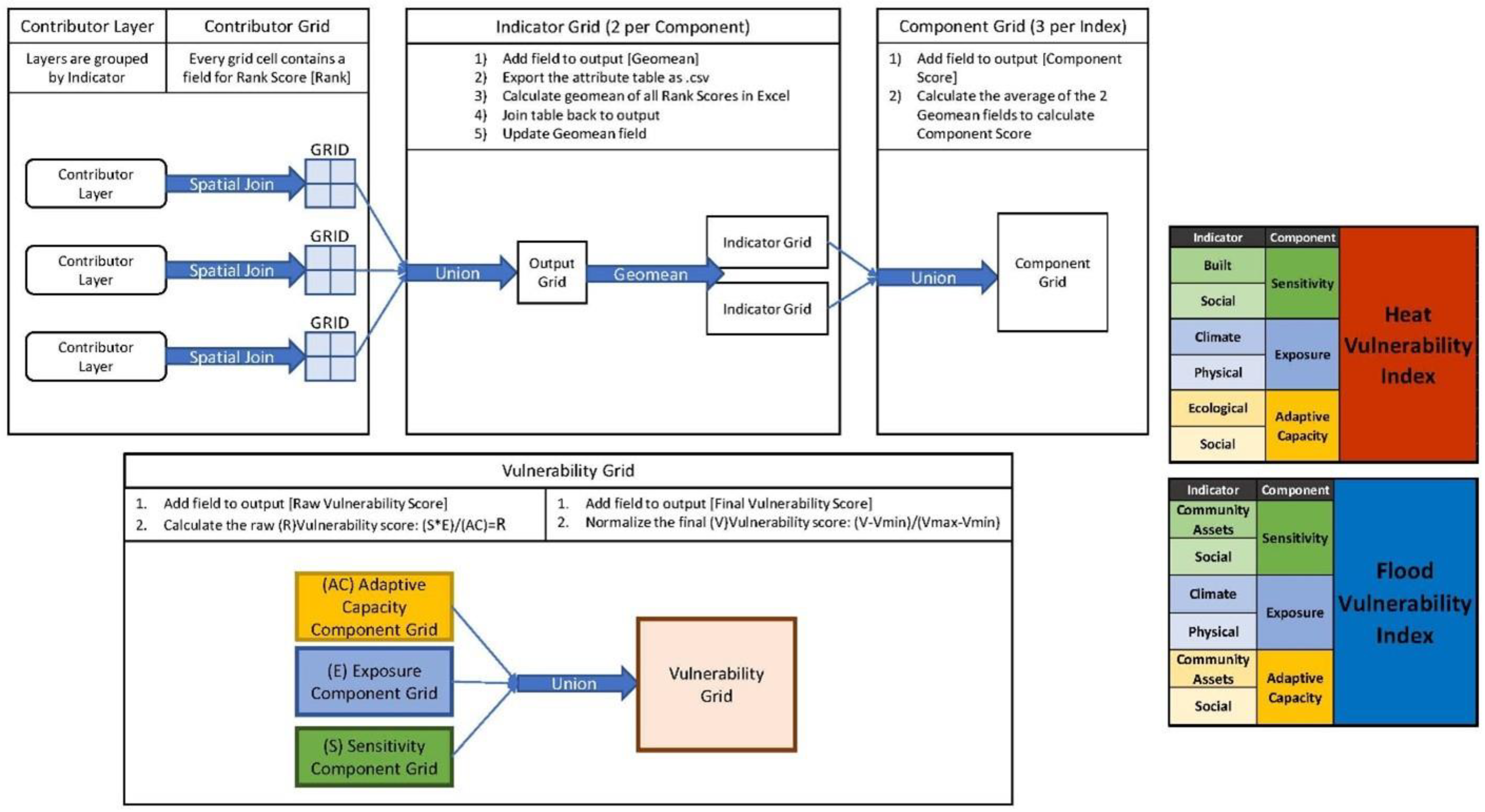
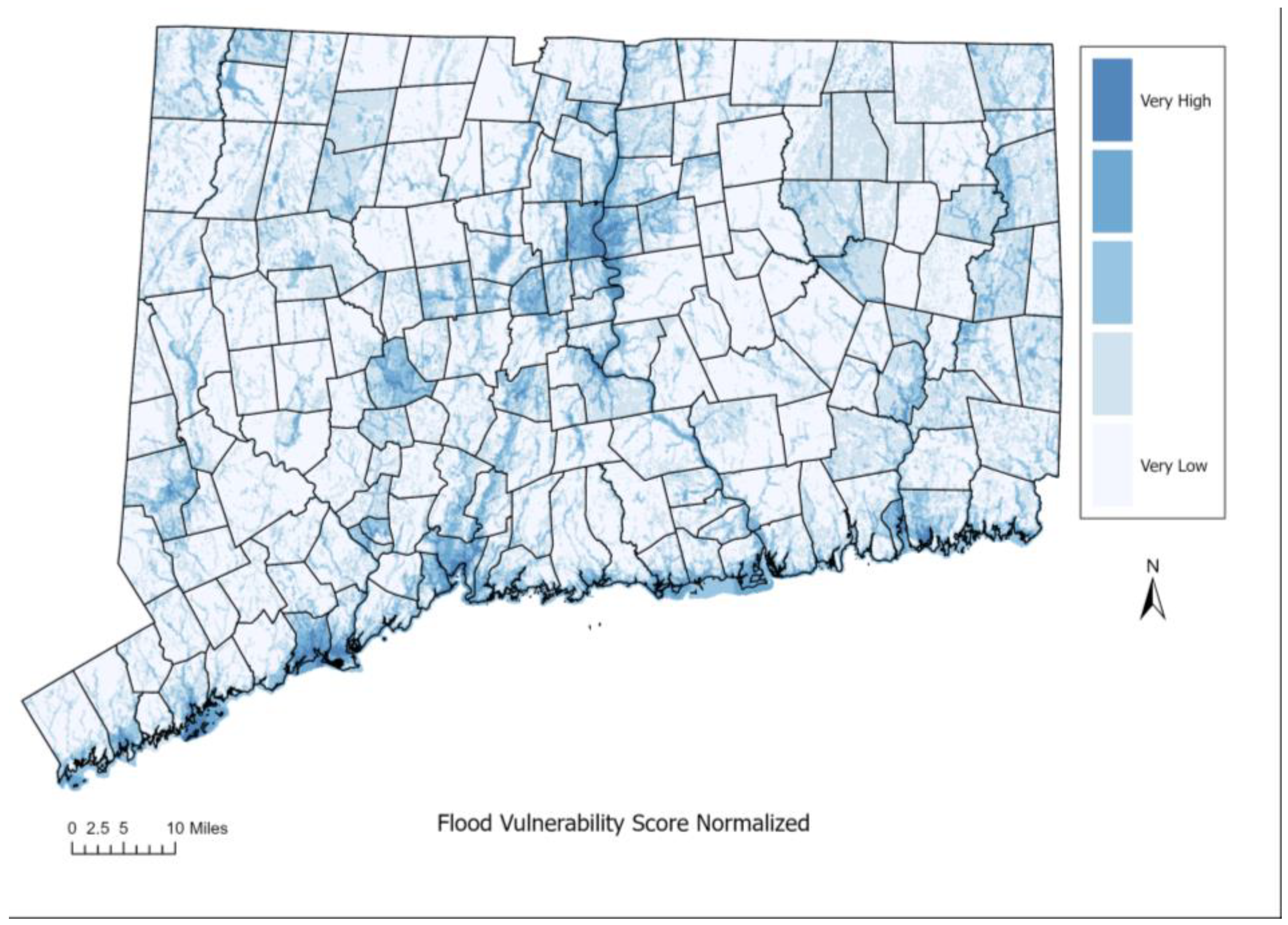
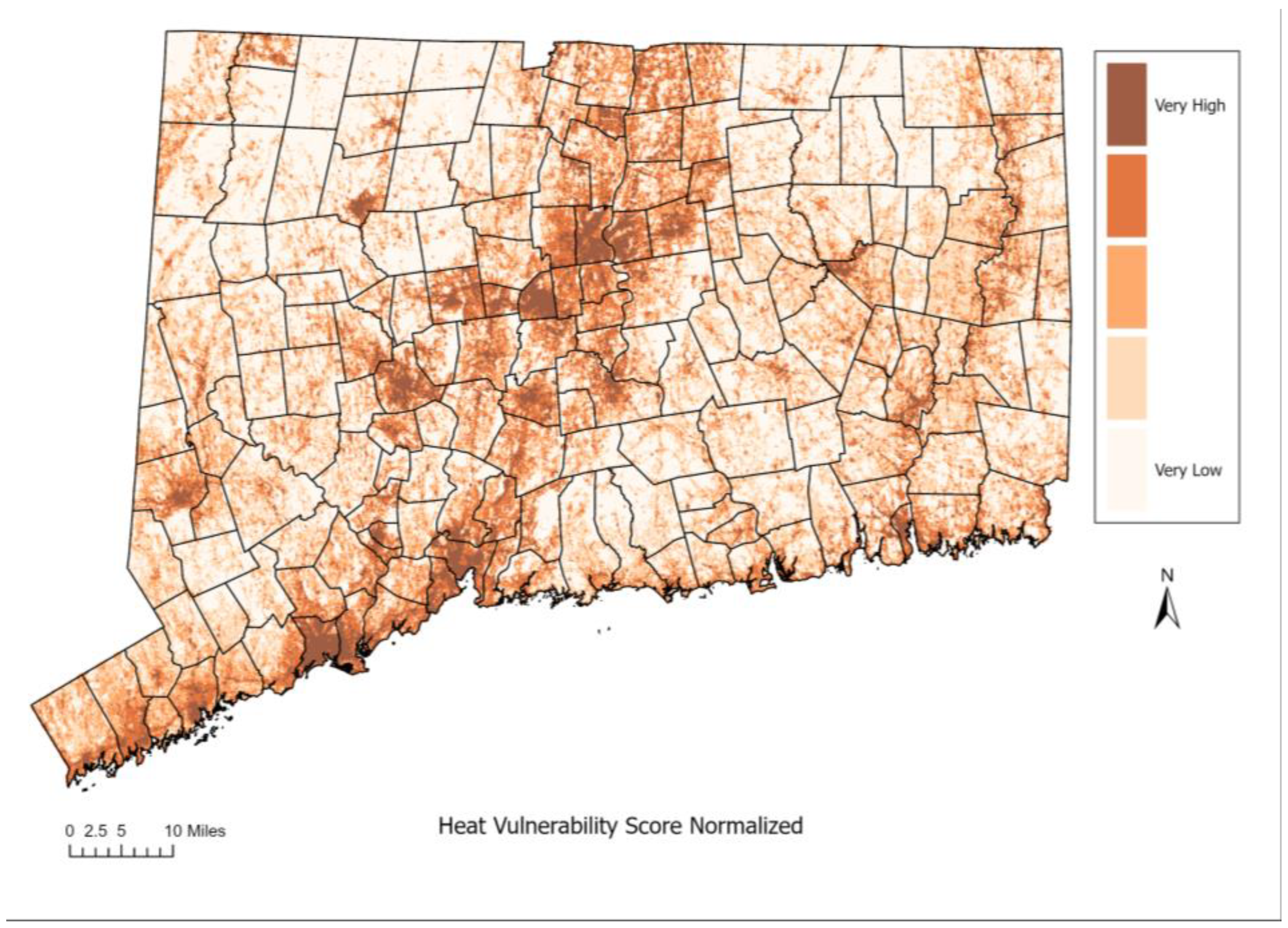
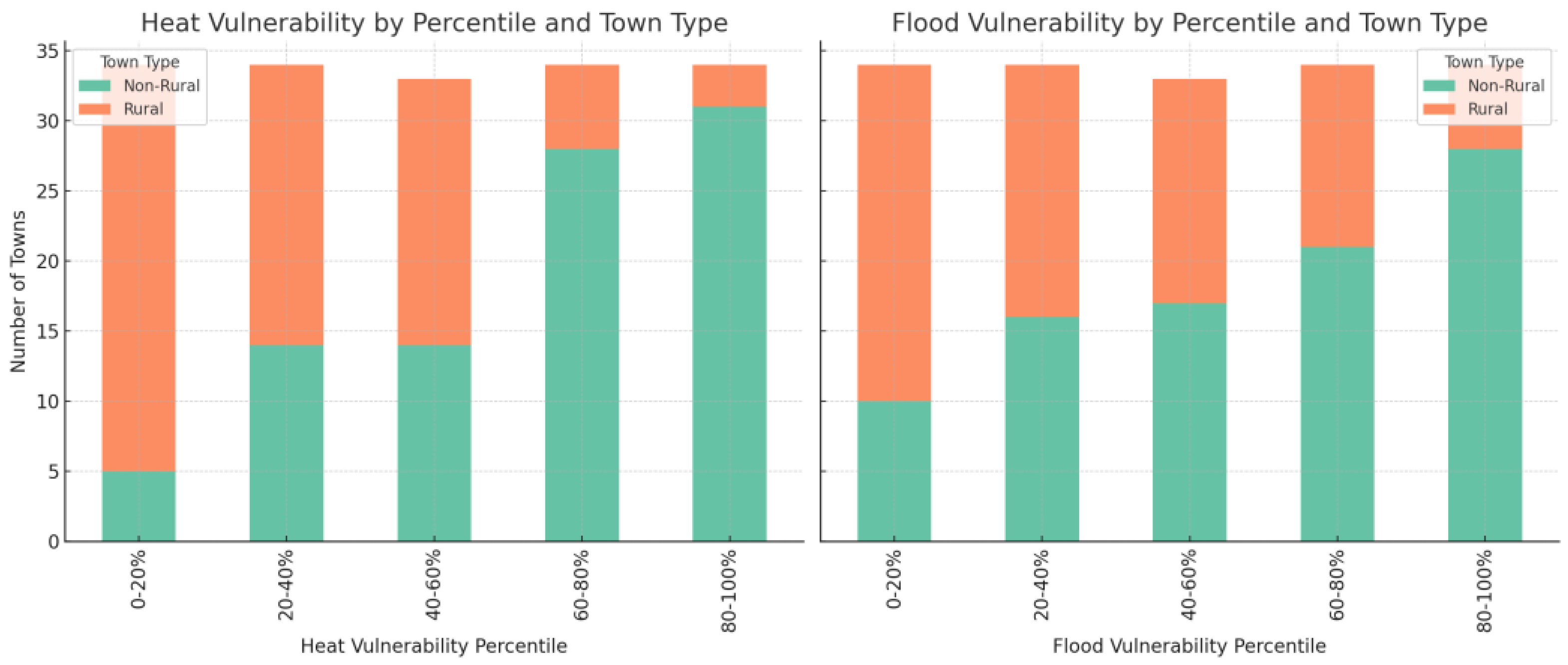
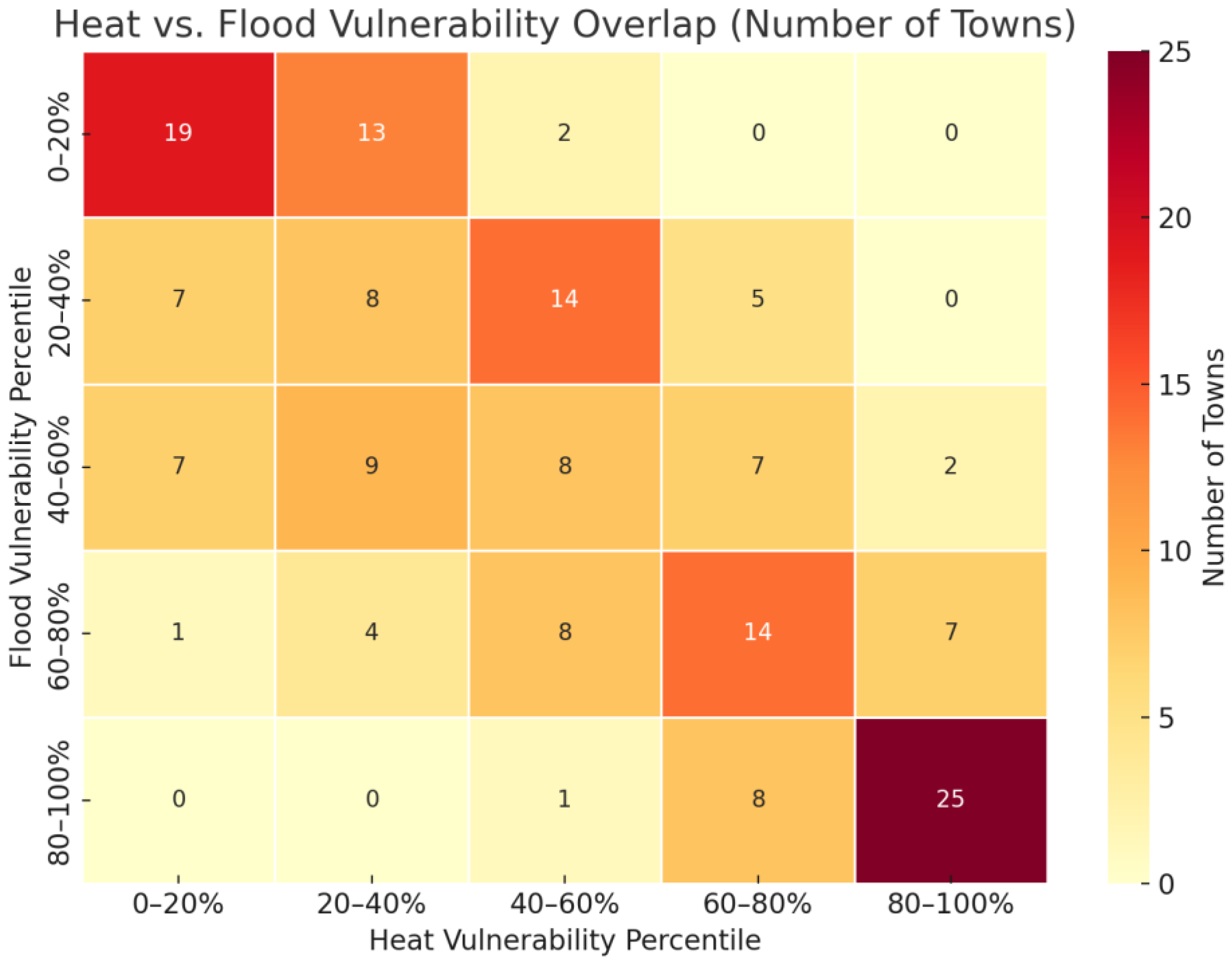
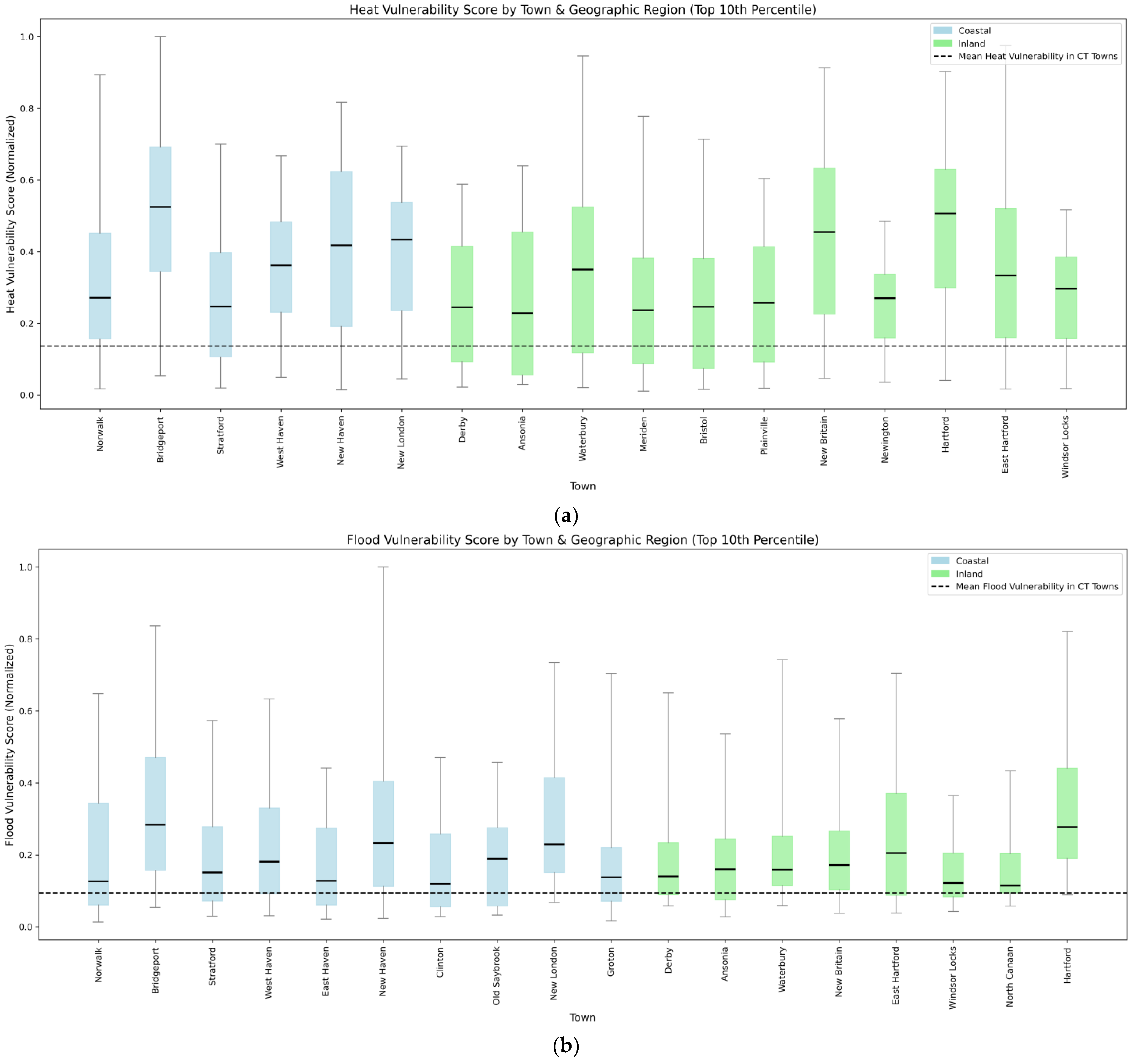
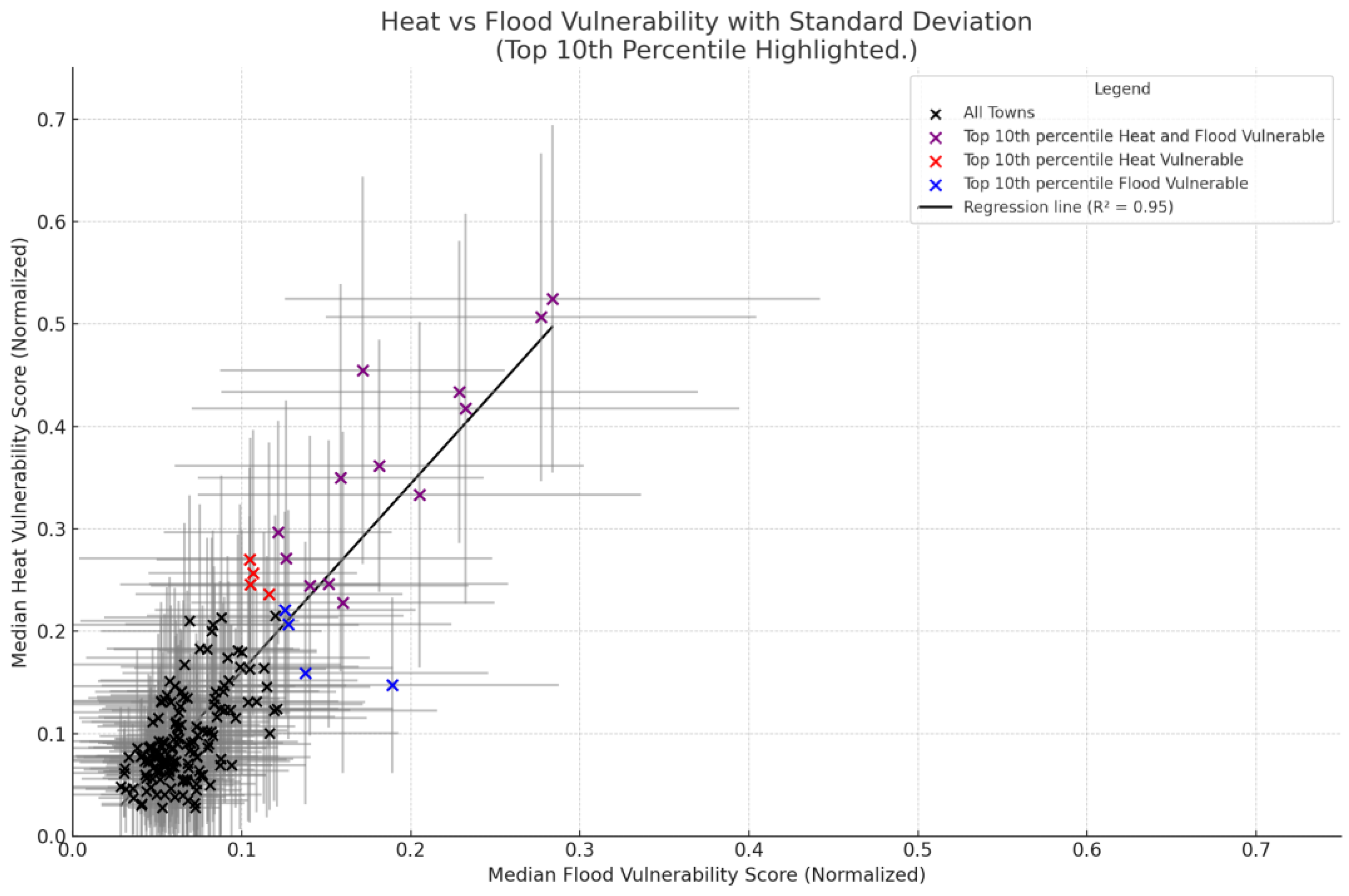


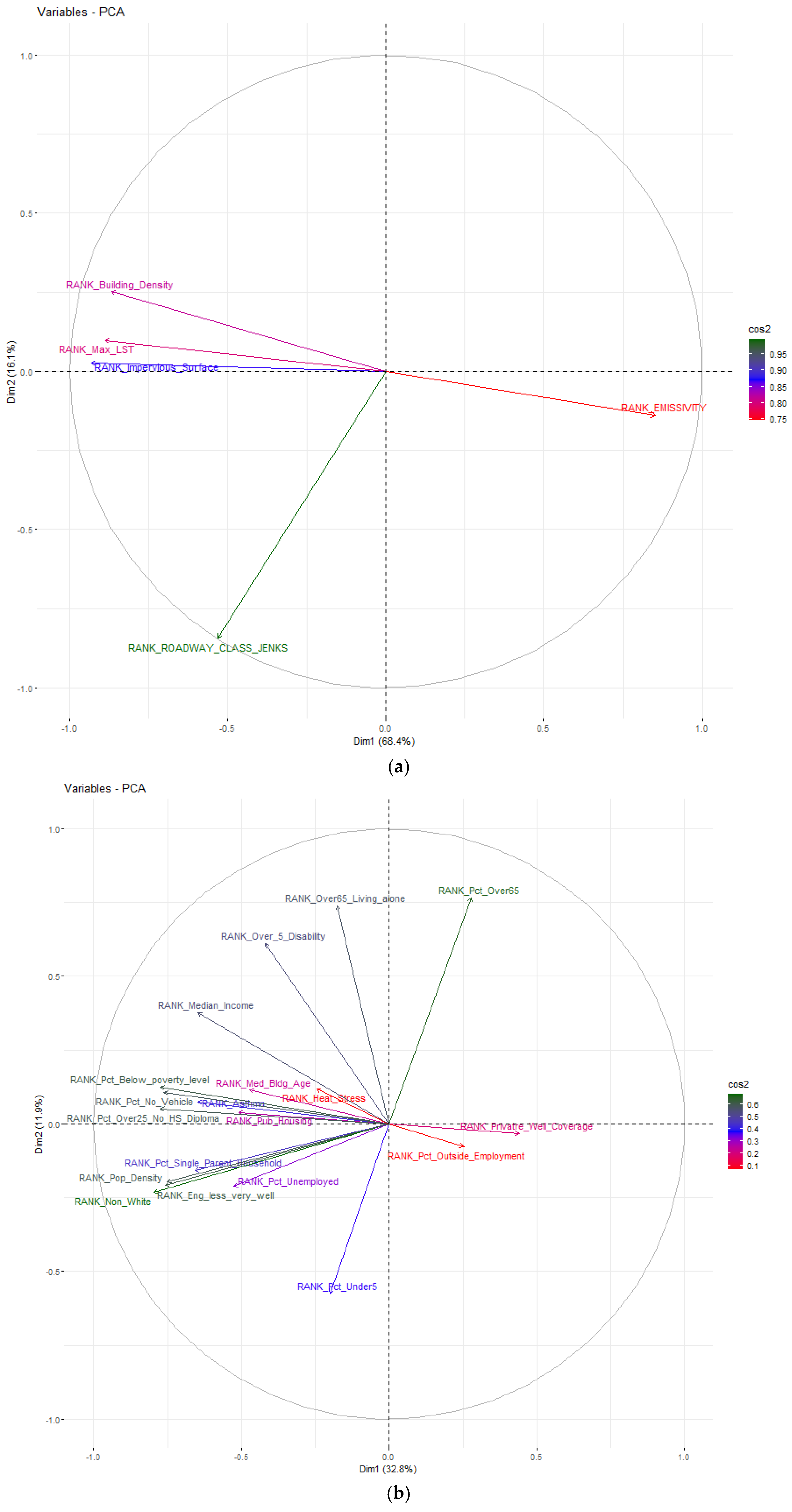

| CCVI | Component Category | Indicator Type | Indicator | Data Source | |
|---|---|---|---|---|---|
| Flood | Adaptive Capacity | Community Assets | Proximity to Healthcare Facility | Homeland Infrastructure Foundation-Level Data (HIFLD) (https://hifld-geoplatform.hub.arcgis.com/pages/hifld-open), Hospitals & Urgent Care Facilities | |
| Proximity to Shelter | COG provided data supplemented with CT DEMHS (https://portal.ct.gov/despp/services/emergency-management-and-homeland-security?language=en_US) and municipal websites | ||||
| Proximity to Major Roadways | CT DOT Roadway Classifications and Exits (https://connecticut-ctdot.opendata.arcgis.com/maps/65d7254355bb4466871cd7c5ea8a6a5d/about) | ||||
| Public Water Service Area | CT Water Supply Plan (DPH) (https://maps.ct.gov/portal/apps/experiencebuilder/experience/?id=1a8bf90b37b24affaeb41a41d71c9417&draft=true) | ||||
| Regulatory Standards | Municipal Websites, provided by CIRCA | ||||
| Sewer Service Areas | CT DEEP (https://maps.ct.gov/portal/apps/experiencebuilder/experience/?id=1a8bf90b37b24affaeb41a41d71c9417&draft=true) | ||||
| Percent Open Space in SFHA | CT DEEP (2022) (https://geodata.ct.gov/datasets/CTDEEP::protected-open-space-view/about) | ||||
| Resilient Landscapes | The Nature Conservancy (https://www.conservationgateway.org/ConservationByGeography/NorthAmerica/UnitedStates/edc/reportsdata/terrestrial/resilience/Pages/default.aspx) | ||||
| Water Company Land | CT DPH (https://maps.ct.gov/portal/apps/experiencebuilder/experience/?data_id=dataSource_1-Exclusive_Service_Areas_1710%3A%2CdataSource_1-Private_Well_Parcels_4899%3A%2CdataSource_1-Connected_Sewer_Service_Areas_8716%3A%2CdataSource_1-ESA_Changes_6777%3A%2CdataSource_1-Drinking_Water_Watersheds_5159%3A199%2CdataSource_1-Aquifer_Protection_Areas_312%3A%2CdataSource_1-Connecticut_CAMA_and_Parcel_Layer_6551%3A%2CdataSource_1-SourceWater_1012%3A%2CdataSource_1-Buffered_Community_PWS_Service_Areas_3916%3A&draft=true&id=1a8bf90b37b24affaeb41a41d71c9417) | ||||
| Social | Percent of Owner-Occupied Housing Units | DP04: Census ACS 2015–2019 5-year Estimates (https://www.census.gov/programs-surveys/acs/technical-documentation/table-and-geography-changes/2019/5-year.html) | |||
| 2022 Average Disposable Income (Esri) | ESRI (https://www.arcgis.com/home/item.html?id=706993115a5842f6b45d563d35a74109), U.S. Census Bureau | ||||
| Percent Housing Units with No Vehicle Present | DP04: Census ACS 2015–2019 5-year Estimates (https://www.census.gov/programs-surveys/acs/technical-documentation/table-and-geography-changes/2019/5-year.html) | ||||
| Exposure | Climate | CIRCA-Modified Flood Zone (Q3, DFIRM, Preliminary) | FEMA (https://www.fema.gov/flood-maps) | ||
| CIRCA Sea Level Rise | CIRCA-Mean High High Water with 20-inch sea level rise (https://resilientconnecticut.uconn.edu/datasets/connecticut-sea-level-rise-viewer/) | ||||
| Storm Surge | SLOSH Category 4 data from NOAA (https://www.arcgis.com/home/item.html?id=1b2c267aa3a547ba9eea5e40faa3b9c2) | ||||
| Physical | Elevation Pooling | CT ECO 2016 LIDAR (https://maps.cteco.uconn.edu/data/flight2016/) | |||
| Erosion Susceptibility | CT DEEP (https://ct-deep-gis-open-data-website-ctdeep.hub.arcgis.com/datasets/erosion-susceptibility/explore) | ||||
| Shoreline Change Rate | NOAA, NGS, CT DEEP | ||||
| Impervious Surfaces | CT ECO 2012 Impervious Surface (https://maps.cteco.uconn.edu/projects/ms4/impervious2012/) | ||||
| Soil Drainage | SSURGO Soil Drainage Class (https://www.nrcs.usda.gov/resources/data-and-reports/soil-survey-geographic-database-ssurgo) | ||||
| Sensitivity | Community Assets | Brownfields | CT DEEP (https://portal.ct.gov/deep/remediation--site-clean-up/brownfields/brownfields-site-inventory) | ||
| Proximity to Bus Hubs (Plus transit, bus stations) | US DOT Bureau of Transportation Statistics (https://www.bts.gov/), SLR | ||||
| Critical Facilities | Compiled from Natural Hazard Mitigation Plans, COG-provided data, and CT DEMHS | ||||
| Railroad Stations | CT Open Data for railroads—joined to building footprints. (https://geodata.ct.gov/datasets/CTDEEP::connecticut-railroads/explore?location=41.517557%2C-72.747450%2C7.69) | ||||
| Roadways | CT DOT (https://connecticut-ctdot.opendata.arcgis.com/maps/5e334f57a37f4eaa970b0ee5a52624d0/about) | ||||
| Railways | CT DEEP (https://ct-deep-gis-open-data-website-ctdeep.hub.arcgis.com/datasets/connecticut-railroads/explore) | ||||
| Septic Areas (outside of sewer service area) | SLR erased the CT DEEP sewer service area from the project boundary (https://ct-deep-gis-open-data-website-ctdeep.hub.arcgis.com/datasets/CTDEEP::connected-sewer-service-areas/explore) | ||||
| Private Wells in SFHA | CT DWVARP (https://portal.ct.gov/dph/drinking-water/dws/drinking-water-vulnerability-assessment-and-resilience-plan-dwvar-plan) | ||||
| Building Density | CT ECO 2012 Impervious Surface (https://maps.cteco.uconn.edu/projects/ms4/impervious2012/) | ||||
| Historic Buildings (SHPO) | SHPO (https://portal.ct.gov/DECD/Content/Historic-Preservation), Dewberry | ||||
| Critical Habitat | CT DEEP (https://ct-deep-gis-open-data-website-ctdeep.hub.arcgis.com/datasets/critical-habitats/explore) | ||||
| Public Water Supply Watersheds | CT DPH watersheds (WUCC/DPH) (https://maps.ct.gov/portal/apps/experiencebuilder/experience/?id=1a8bf90b37b24affaeb41a41d71c9417&draft=true) | ||||
| Social | Household Median Income | S1901_C01_012E | Census ACS 2015–2019 5-year Estimates (https://www.census.gov/programs-surveys/acs/technical-documentation/table-and-geography-changes/2019/5-year.html) | ||
| Over 5 with a Disability | B18101 | ||||
| Percent Living Below 185% Federal Poverty Level | S1701_C01_041E | ||||
| Percent Over 25 without a high school diploma | S0601_C01_033E | ||||
| Percent Over 65 | S0101_C02_030E | ||||
| Percent population under 5 | S0101_C02_002E | ||||
| Percent population unemployed | DP03_0005PE | ||||
| Population density | S0101 | ||||
| Non White Population | S0601_C01_022E | ||||
| Speaks English less than well/not at all | S0601_S0601_C01_026E | ||||
| Over 65 Living Alone (households) | B25011 | ||||
| Single-parent households | DP02 | ||||
| Heat | Adaptive Capacity | Ecological | Percent Tree Cover | USFS 2016 Percent Tree Canopy (https://data.fs.usda.gov/geodata/rastergateway/treecanopycover/) | |
| Normalized Difference Vegetation Index (NDVI) | CIRCA provided Landsat 8 image processed through median values from 2013–2022 during all summers (June–September), see Supplementary Material | ||||
| Social | Proximity to Bus Hubs (Plus transit, bus stations) | US DOT Bureau of Transportation Statistics (https://www.bts.gov/), CT DOT | |||
| Percent population with (no) health insurance | B27010 Census ACS 2015–2019 5-year Estimates | ||||
| Proximity to Swimming Areas | CIRCA and SLR compiled swimming area data from CT DEEP (https://portal.ct.gov/deep/state-parks/recreation-information/swimming---ct-state-parks-and-forests) and CT DPH (https://portal.ct.gov/dph/environmental-health/recreation/public-pools) | ||||
| Proximity to Healthcare Facility | Homeland Infrastructure Foundation-Level Data (HIFLD) (https://hifld-geoplatform.hub.arcgis.com/pages/hifld-open), Hospitals & Urgent Care Facilities | ||||
| Proximity to Shelter | COG provided data supplemented with CT DEMHS (https://portal.ct.gov/despp/services/emergency-management-and-homeland-security?language=en_US) and municipal websites | ||||
| Proximity to Cooling Center | CIRCA provided known cooling center locations based on consultations with municipalities in 2022. | ||||
| Exposure | Climate | Maximum Land Surface Temperature | CIRCA provided Landsat 8 image processed through median values from 2013–2022 during all summers (June–September), see Supplementary Material | ||
| Physical | Emissivity | CIRCA provided Landsat 8 image processed through median values from 2013–2022 during all summers (June–September), see Supplementary Material | |||
| Roadway Usage Classification (Traffic Emissions) | CT DOT (https://geodata.ct.gov/maps/65d7254355bb4466871cd7c5ea8a6a5d/about) | ||||
| Impervious surfaces | CT ECO 2012 Impervious Surface (https://maps.cteco.uconn.edu/projects/ms4/impervious2012/) | ||||
| Sensitivity | Built | Private Well Coverage | CT DWVARP (https://portal.ct.gov/dph/drinking-water/dws/drinking-water-vulnerability-assessment-and-resilience-plan-dwvar-plan) | ||
| Median Structure Age | B25035_001E: Census ACS 2015–2019 5-year Estimates (https://www.census.gov/programs-surveys/acs/technical-documentation/table-and-geography-changes/2019/5-year.html) | ||||
| Public Housing Units | US Dept of Housing and Urban Development (https://www.huduser.gov/portal/pdrdatas_landing.html) & B25001 Census ACS 2015–2019 5-year Estimates (https://www.census.gov/programs-surveys/acs/technical-documentation/table-and-geography-changes/2019/5-year.html) | ||||
| Social | Average number of emergency visits for asthma, per 10,000 population | CT DPH Asthma Statistics, 2012–2019 age-adjusted rate of emergency department visits per 10,000 (https://portal.ct.gov/DPH/Health-Education-Management--Surveillance/Asthma/Asthma-Statistics) | |||
| Heat Stress | CT DPH 2013–2017 heat stress-related emergency department visits per 100,000 (https://maps.ct.gov/portal/home/item.html?id=ac51c59d5f6d4295afb940c363217bf8) | ||||
| Percent living below 185% of the federal poverty level | S1701_C01_041E | Census ACS 2015–2019 5-year Estimates (https://www.census.gov/programs-surveys/acs/technical-documentation/table-and-geography-changes/2019/5-year.html) | |||
| Percent over 25 without a high school diploma | S0601_C01_033E | ||||
| Population density | S0101 | ||||
| Outside Employment | US Census OnTheMap (https://onthemap.ces.census.gov/) | ||||
| Index Name | Total Variance (PC1 + PC2) | PC1 Variance (%) | PC2 Variance (%) | PC1 Dominant Indicators | PC2 Dominant Indicators | Highest Cos2 Indicators |
|---|---|---|---|---|---|---|
| Flood CCVI | 27.32% | 14.86 | 12.46 | % Non-white population, % Speaks English less well, % No vehicle, Public water service area | Median income, Disposable income, % Population with disability, % Owner-occupied housing | Median income, Disposable income, % Below 185% poverty |
| Flood Exposure | 44.62% | 24.49 | 20.13 | Erosion susceptibility, Elevation pooling, Impervious surfaces, Modified flood zone median | Soil drainage, Modified flood zone median, Shoreline change rate, Impervious surfaces | Modified Flood Zone Median, Soil Drainage, Erosion Susceptibility |
| Flood Sensitivity | 37.90% | 21.76 | 16.14 | % Population below 185% poverty, % Population over 25 with no high school diploma, % Population speaks English less well, % Population non-white | % Population over 65, % Population live alone and over 65, % Population with disability, % Population under 5 years | Median income, % Non-white population, % Population with disability |
| Flood Adaptive Capacity | 52.75% | 36.62 | 16.13 | Public Water Service, Regulatory Standards, Proximity to health care facility, major roadways | Disposable income, % Owner-occupied housing, % No access to vehicle, Resilient landscapes | Disposable income, % Owner-occupied housing, % No access to vehicle |
| Heat CCVI | 39.95% | 30.15 | 9.80 | Max land surface temperature, Impervious surface, Emissivity, % Population non-white | % Population below poverty level, Median income, % Population over 25 with no high school diploma, Normalized difference vegetation index | % Below poverty level, Normalized difference Vegetation index, Impervious surface |
| Heat Exposure | 84.49% | 68.39 | 16.10 | Impervious surface, Max. land surface temperature, Building density, Emissivity | Roadway classifications, Building density, Emissivity, Max land surface temperature | Roadway classification, Building density and impervious surfaces |
| Heat Sensitivity | 44.63% | 32.75 | 11.89 | Non-white population, % Below poverty level, % Population over 25 with no high school diploma, % Population with no access to vehicle | % Population over 65, % Population live alone and over 65, % Population with disability, % Population under 5 years | % Population live alone and over 65, % Population with disability |
| Heat Adaptive Capacity | 50.75% | 36.78 | 13.97 | Normalized difference Vegetation index, Cooling centers, Proximity to bus hubs, Proximity to healthcare facilities | Swimming area, Swimming access, Swimming proximity, Proximity to bus hubs | Swimming area, Swimming access, Swimming proximity |
Disclaimer/Publisher’s Note: The statements, opinions and data contained in all publications are solely those of the individual author(s) and contributor(s) and not of MDPI and/or the editor(s). MDPI and/or the editor(s) disclaim responsibility for any injury to people or property resulting from any ideas, methods, instructions or products referred to in the content. |
© 2025 by the authors. Licensee MDPI, Basel, Switzerland. This article is an open access article distributed under the terms and conditions of the Creative Commons Attribution (CC BY) license (https://creativecommons.org/licenses/by/4.0/).
Share and Cite
Onat, Y.; Govert, N.; Buchanan, M.; Murphy, D.; McGaffin, M.; Dickes, C.; Duskin, L.; Vetre, V.; Truscinski, J.; O’Donnell, J. Development of a Statewide Climate Change Vulnerability Index for Heat and Flood: A Comprehensive Assessment of Connecticut for Resiliency Planning. Geographies 2025, 5, 28. https://doi.org/10.3390/geographies5030028
Onat Y, Govert N, Buchanan M, Murphy D, McGaffin M, Dickes C, Duskin L, Vetre V, Truscinski J, O’Donnell J. Development of a Statewide Climate Change Vulnerability Index for Heat and Flood: A Comprehensive Assessment of Connecticut for Resiliency Planning. Geographies. 2025; 5(3):28. https://doi.org/10.3390/geographies5030028
Chicago/Turabian StyleOnat, Yaprak, Nicole Govert, Mary Buchanan, David Murphy, Meghan McGaffin, Conner Dickes, Libbie Duskin, Victoria Vetre, John Truscinski, and James O’Donnell. 2025. "Development of a Statewide Climate Change Vulnerability Index for Heat and Flood: A Comprehensive Assessment of Connecticut for Resiliency Planning" Geographies 5, no. 3: 28. https://doi.org/10.3390/geographies5030028
APA StyleOnat, Y., Govert, N., Buchanan, M., Murphy, D., McGaffin, M., Dickes, C., Duskin, L., Vetre, V., Truscinski, J., & O’Donnell, J. (2025). Development of a Statewide Climate Change Vulnerability Index for Heat and Flood: A Comprehensive Assessment of Connecticut for Resiliency Planning. Geographies, 5(3), 28. https://doi.org/10.3390/geographies5030028






